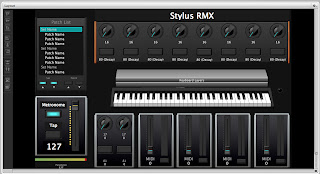Today we'll be taking a closer look at the sound of a Rhodes and Wurli. These have become some of my favorite sounds to play! In fact, I probably play them as much as I play piano. What's great about these instruments is many times they can be played instead of piano and will add a very different character to the song.
The Rhodes
The Rhodes has a bell type of tone with lots of body. If you add some effects such as delay or tremolo you can create a more spacious sound that can really fill in a mix. You hear it used a lot in the Hillsong United and Jesus Culture albums. A great example of a Rhodes sound is in the intro of the song "Forever Reign" from Hillsong's Beautiful Exchange Live album (video below). The sound is pretty much a straight Rhodes with some delay for effect. Another example is in the song "Revelation Song" on the Consumed album by Jesus Culture where you can hear it throughout the verses.
Another cool thing about the Rhodes is that the original instrument uses pickups similar to an electric guitar, which means you can make some great "electric guitar" sounds with a little creativity. To accomplish this, just run the Rhodes through a simulated guitar amp and crank up the gain until it starts to sound distorted. Then apply EQ, delay and reverb to taste and you have a killer electric guitar-ish sound! When playing a sound like this you want to make sure that you approach it like a guitar player and not a piano player. It's really a lead instrument so you won't be playing chords but more individual notes and if you use a lot of delay (like I do) then you can play even less and have a HUGE sound.
The Wurli (Wurlitzer)
A Wurli (or Wurlitzer) is typically classified in the same category as a Rhodes but it has a much sharper attack and less body and almost always has some tremolo applied to it. A great example of this sound is in the verses of "Rain Down" by Delirious on their album Now Is The Time: Live At Willow Creek (video below).
I use it a lot as an alternative to clean guitar parts if I only have one guitar player and want the sound of a second by modifying my playing to try and match the notes of the guitar riff. If you try this you really have to think about the correct inversions a guitar player would use because it will have a huge impact on whether it sounds right or not. It's also great as a replacement for piano as it's a very percussive instrument and cuts through a mix well.
Hopefully this got your creative juices flowing and in the next few articles I'll be covering Organ, Synth Lead, and Synth Pad. If there's another type of sound you'd like me to cover feel free to post it in the comments.
Related Posts
Changing the Time Signature of Loops In Stylus RMX
So You Want To Use Your Computer Live
3 Simple Ways to Optimize Your Computer
Another cool thing about the Rhodes is that the original instrument uses pickups similar to an electric guitar, which means you can make some great "electric guitar" sounds with a little creativity. To accomplish this, just run the Rhodes through a simulated guitar amp and crank up the gain until it starts to sound distorted. Then apply EQ, delay and reverb to taste and you have a killer electric guitar-ish sound! When playing a sound like this you want to make sure that you approach it like a guitar player and not a piano player. It's really a lead instrument so you won't be playing chords but more individual notes and if you use a lot of delay (like I do) then you can play even less and have a HUGE sound.
The Wurli (Wurlitzer)
A Wurli (or Wurlitzer) is typically classified in the same category as a Rhodes but it has a much sharper attack and less body and almost always has some tremolo applied to it. A great example of this sound is in the verses of "Rain Down" by Delirious on their album Now Is The Time: Live At Willow Creek (video below).
I use it a lot as an alternative to clean guitar parts if I only have one guitar player and want the sound of a second by modifying my playing to try and match the notes of the guitar riff. If you try this you really have to think about the correct inversions a guitar player would use because it will have a huge impact on whether it sounds right or not. It's also great as a replacement for piano as it's a very percussive instrument and cuts through a mix well.
Hopefully this got your creative juices flowing and in the next few articles I'll be covering Organ, Synth Lead, and Synth Pad. If there's another type of sound you'd like me to cover feel free to post it in the comments.
Related Posts
Changing the Time Signature of Loops In Stylus RMX
So You Want To Use Your Computer Live
3 Simple Ways to Optimize Your Computer





